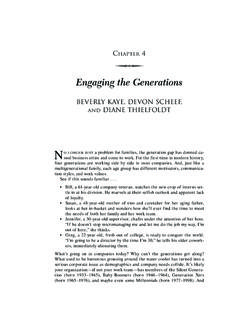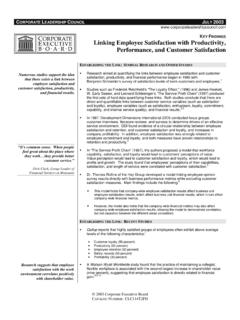Transcription of Towers Perrin Monitor - keepem.com
1 Towers Perrin Monitor Terms of Use Privacy Statement HR Services is a business of Towers Perrin . 2005 Towers Perrin January 2006 printer friendlye-mail to a colleague Employee Engagement Levels Are Focus of Global Towers Perrin StudyCompanies around the world could be doing significantly more to inspire their employees to put in consistent extra effort to improve customer service, manage costs and meet other critical business objectives essential to improved performance, according to a new global Towers Perrin study. The study, reaching roughly 86,000 people working full time for large and midsize companies in 16 countries across four continents, shows that only 14% of all employees worldwide are fully engaged on the job -- willing and able to give sustained discretionary effort to help their organizations succeed. The vast majority are moderately engaged at best and, perhaps most disturbing, nearly a quarter are actively disengaged.
2 This finding comes at a time when more and more companies face intensified competition, both at home and abroad, and cannot afford to lose momentum, energy or brainpower in the struggle to increase market share and innovate. The need to find, keep and engage the right people -- those with the specific skills required for growth -- has never been greater, or more challenging, given the big demographic shifts affecting business conditions and labor markets around the world. The survey, the largest single one of its kind, gives a voice to the workforce worldwide. It affirms that people do want to contribute more, but feel that their companies unintentionally put obstacles in their paths that frustrate and undermine their willingness to give sustained discretionary effort. Among these obstacles: l Failing to adequately differentiate performance and provide rewards that are perceived as fair, consistent and genuinely commensurate with the level of contribution that employees provide.
3 Views about pay, especially the basis for determining salary increases and incentive amounts, were among the most negative in the survey, across virtually all the countries studied. l Failing to give first-line managers the training they need to serve as coaches and mentors for their employees and help those employees develop skills and advance in their careers. Employees look to managers for support and guidance in many of the areas of the work experience that mean the most to them, including training, advancement and performance management. If managers are not sufficiently skilled or accountable themselves, the company suffers on two counts -- not only losing a key conduit to employees, but also putting additional stress on an already overburdened group. l Failing to build appropriate connections between senior management and the workforce. Employees' views about their companies, and their own sense of commitment to their companies, are strongly influenced by their attitudes about the senior leadership team.
4 Employees want to see and hear from their leaders. They want to understand the vision the leadership team has for the company, its plans to move the company ahead and how it sees employees contributing to that vision. If senior management is viewed as distant, noncommunicative or invisible, employees tend to feel far less engaged. Engagement varies dramatically worldwide The survey uses a standard set of nine items to measure employee engagement. These items (Exhibit 1) reflect the emotional and rational connections that define the way people feel about (1 of 5) [1/23/2006 2:05:04 PM] Towers Perrin Monitortheir jobs across countries and cultures. Central to this measure is the notion that truly engaged employees are those who are inspired by their work, feel a strong sense of personal accomplishment in what they do, care about the future of the company and are willing to invest discretionary effort to see that the organization succeeds.
5 We determine the actual engagement levels by scoring responses to all nine items and placing employees into three categories based on their total mean scores. Those with average total scores above a designated high point fall into the highly engaged group. Those with scores below a designated low point fall into the disengaged group. The remainder fall into the moderately engaged group. On a global basis, only 14% of the respondents can be classified as highly engaged. Just under two-thirds (62%) are moderately engaged, and roughly a quarter are disengaged. On a country-by-country basis, these percentages vary considerably -- and in some unexpected ways (Exhibit 2 ). The highest recorded levels of engagement are in Mexico (40%) and Brazil (31%). The lowest recorded levels -- in the low single digits -- are in the four Asian countries in the study. Across Europe and North America, engagement levels fall in between these extremes.
6 The results are similar to those from an earlier Towers Perrin study in the in 2003, although there was a slight erosion in the number of highly engaged and moderately engaged employees, accompanied by a slight increase in the number of disengaged employees. (See the next issue of Monitor for a more detailed discussion of the findings.) These variations confirm that engagement has little to do with the macroeconomic conditions in the country where an employee works. Only 8% of Chinese employees in our survey are highly engaged, despite -- or perhaps because of -- China's fast-growth economy and the stress it puts on people. In Germany s slow-paced economy, by contrast, almost twice as many employees (15%) are highly engaged. One reason for this somewhat surprising pattern is that engagement levels are related to the extent to which employees feel they re continually at the mercy of significant change -- whether positive or negative.
7 And change is driven by technology, globalization and a host of related factors that are dramatically reshaping the business environment from Asia to North America. So it's hardly surprising that so many employees exhibit a sense of dislocation and frustration at what they see as an ever-changing employment "deal" with their employers. The challenge for companies seeking to improve engagement levels is to determine the unique elements of the work experience that are most likely to influence engagement in each country or region in which they operate. Exhibit 3 shows the elements that have the greatest impact for the global respondent sample as a whole. While these elements do vary across the individual countries in our study, there are common themes that cut across all of the countries we studied. One theme is the importance of training and skill enhancement. This is a key element for employees virtually everywhere in the world.
8 Another is the visibility and competence of senior management. A third is the company's reputation as a good employer. Employees want to work for a company known to have progressive people practices and to nurture talent. These drivers of higher engagement form the beginnings of a road map that can help companies determine optimal areas for focus and investment in the various locations in which they operate. The benefits of higher engagement There are solid business reasons for investing in improving engagement. Another key finding from this survey, validated in many other studies, is that higher levels of engagement benefit a company directly because of the direct link to employee performance. Specifically, the study shows that highly engaged workers are more likely to believe they can and do contribute more directly to business results. For instance: l 84% of highly engaged employees believe they can positively impact the quality of their company s products, compared with only 31% of the disengaged.
9 L 72% of the highly engaged believe they can positively affect customer service, versus 27% of the disengaged. l 68% of the highly engaged believe they can positively impact costs in their job or unit, (2 of 5) [1/23/2006 2:05:04 PM] Towers Perrin Monitorversus 19% of the disengaged. Higher engagement also helps retention because highly engaged employees are far less likely to leave for another job than their less engaged peers. Worldwide, 59% of the highly engaged survey respondents planned to stay with their current employer, compared with just 24% of the disengaged group ( Exhibit 4). This is an important finding for many companies facing a shortage of skilled people as large numbers of workers move toward retirement age. Given the link between higher engagement levels and performance, the companies that do better at engaging employees are better positioned to enhance their competitiveness by retaining a greater number of talented people.
10 By contrast, those with low employee engagement levels are in effect burdening their organization with a disproportionate number of people who can t be counted on to deliver better results to shareholders. Watch future issues of Monitor for more articles on the Towers Perrin 2005 Workforce Study. (3 of 5) [1/23/2006 2:05:04 PM] Towers Perrin Monitor (4 of 5) [1/23/2006 2:05:04 PM] Towers Perrin Monitor Back to top Copyright 2006 Towers Perrin . All rights reserved. (5 of 5) [1/23/2006 2:05:04 PM]


